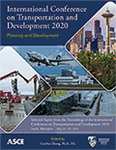International Conference on Transportation and Development 2020
Investigation and Modeling of Financial Risks Associated with PPP Road Projects in India
Publication: International Conference on Transportation and Development 2020
ABSTRACT
In the last two decades, there is an increased demand for the infrastructure development but because of having constraints like finance or lack of experience and expertise in building and operating the facility has led governments to adopt a Public-Private-Partnership model which is popularly known as “PPP” model. PPP model encourages private sector to involve in development of infrastructure and in provision of public services. According to the World Bank, India is one of the leading countries in terms of readiness for PPPs. Government of India is looking forward for huge investments in India by private companies mainly in infrastructure development. The road sector, accounting for nearly 80% of all PPP projects, dominates the PPP scenario in India. Among various PPP models, the commonly adopted models in India are design-build-operate-transfer (DBOT), Build-own-operate-transfer (BOOT) and build-operate-transfer (BOT). Typically, PPP road projects are long term in nature and have many risks associated with them. Many of the past PPP projects have either been delayed or abandoned due to insufficient financial risk management. This paper focuses towards the financial risks associated with the BOT road projects in India with the real-world road projects data. The net present value (NPV)-at-risk method is used for the evaluation of critical risks. NPV-at-risk financial risks model is developed which can be used as decision tool. The developed financial risk model also uses Monte Carlo simulation for the consideration of the probability distributions associated with the input risk parameters. The developed model can provide better decision for risk evaluation of and investment in privately financed infrastructure projects. It can also be used for the identification of the most influential source of uncertainty for the financial returns.
Get full access to this article
View all available purchase options and get full access to this chapter.
REFERENCES
1. A. V. Thomas, S. N. (2006). Modelling and assessment of critical risks in BOT road. Construction Management and Economics, Taylor and Francis, 407-424.
2. C. Cui, Y. L. (2018). Review of studies on the public–private partnerships (PPP). International Journal of Project Management, Elsevier.
3. Fahim Ullah, M. J. (2018). System Dynamics Model to Determine concession period of PPP Infrastructure Projects : Overarching effects of critical success factors. Journal of Legal Affairs and Dispute Resolution in Engineering and Construction, © ASCE.
4. GOI. (n.d.). https://www.pppinindia.gov.in/. Retrieved from https://www.pppinindia.gov.in/.
5. GOI. (2009). Report of the Committee of Secretaries on Review of Toll Policy for National Highways. Government of India.
6. Infrascope. (2015). Evaluating the environment for PPPs in Asia-Pacific 2014. Economic Intelligence Unit.
7. Jeerangsuwan, T. a. (2012). Financial viability evaluation for a toll road project considering serviceability. International Conference on construction in Developing Countries.
8. Jeerangsuwan, T., Said, H., Kandil, A., & Ukkusuri, a. S. (2014). Financial Evaluation for Toll Road Projects Considering Traffic Volume and Serviceability Interactions. Journal of Infrastructure Systems, ASCE.
9. Kadiyali, L. (2013). Traffic Engineering and Transport Planning. Khanna Publishers.
10. Toll Information System. Retrieved from National Highway Authority of India: http://tis.nhai.gov.in/.
11. L. Kumar, A. J. (2018). Financial risk assessment and modelling of PPP based Indian highway infrastructure projects. Transport Policy, Elsevier, 2-11.
12. Levitt, D. A. (1980). Allocating risk and incentive in Construction.Journal of Construction Division, ASCE, 106(CO3), 297–305.
13. Li, Y. W. (2016). Using bargaining game theory for risk allocation of public-private partnership projects: insights from different alternating offer sequences of participants. J. Constr. Eng. Manag., 143 (3).
14.M. Attarzadeh, D. K. (2011). Risk management of Long Term Infrastructure Projects “PPP-BOT projects” by using Uncertainty, Probabilistic and Stochastic Methods and Models. Vulnerability, Uncertainty, and Risk, 360–367.
15. R. L. K. Tiong, S. Y. (2000). NPV-AT-RISK method in infrastructure project investment evaluation. Journal of Construction Engineering and Management, 227–233.
16. Sinha, K. C. ((2007). Transportation decision making: Principles of project evaluation and programming. Wiley, Hoboken, NJ.
17. Swapan Kumar Bagui, A. G. (2012). Road Project Investment Evaluation Using Net Present Value (NPV) at risk method. Jordan Journal of Civil Engineering, Volume 6.
18. Thomas, A. (2003). Identification, assessment and allocation of critical risks in Indian BOT road projects.
19. Yiannis Xenidis, D. A. (2005). The financial risks in build-operate-transfer projects. Construction Management and Economics, Taylor & Francis, 23, 431–441.
20. Zhang, X. (2005). “Financial viability analysis and capital structure optimization in privatized public infrastructure projects. Journal of Construction Engineering Management.
Information & Authors
Information
Published In
International Conference on Transportation and Development 2020
Pages: 309 - 318
Editor: Guohui Zhang, Ph.D., University of Hawaii
ISBN (Online): 978-0-7844-8316-9
Copyright
© 2020 American Society of Civil Engineers.
History
Published online: Aug 31, 2020
Published in print: Aug 31, 2020
Authors
Metrics & Citations
Metrics
Citations
Download citation
If you have the appropriate software installed, you can download article citation data to the citation manager of your choice. Simply select your manager software from the list below and click Download.
